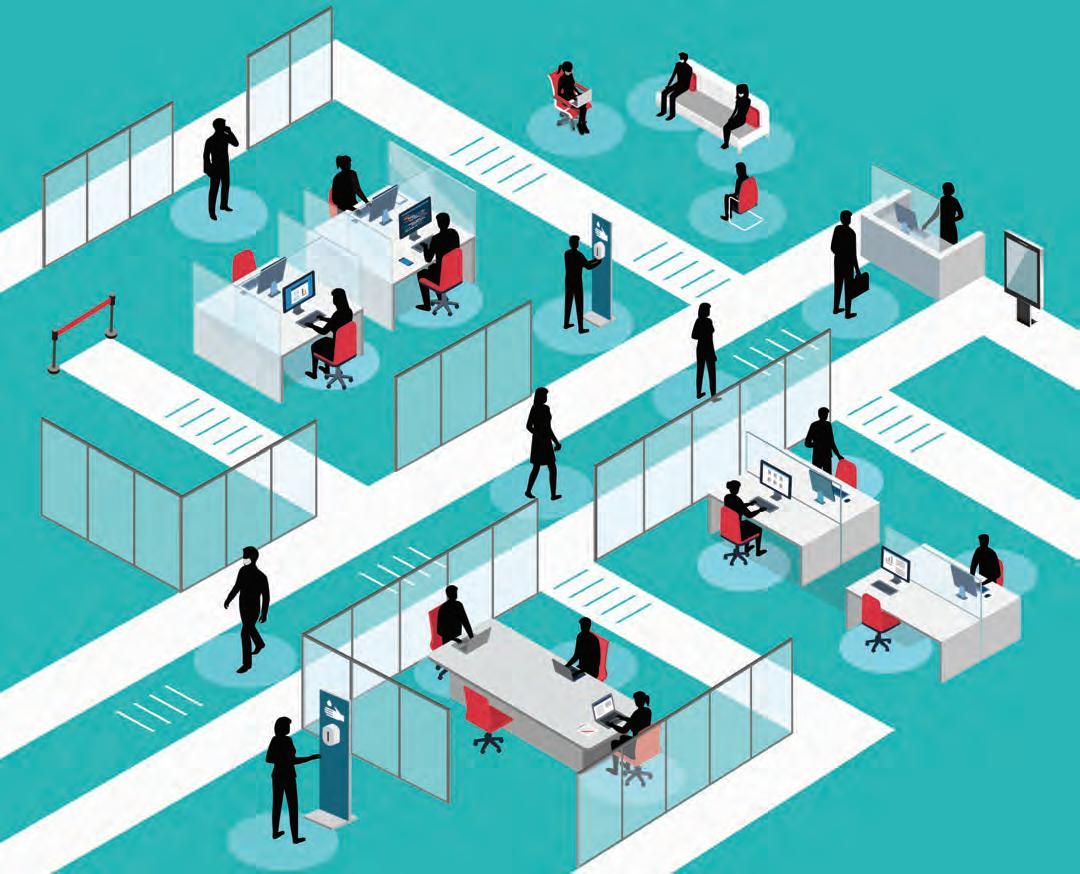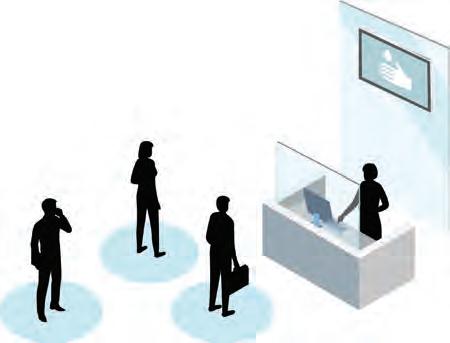
10 minute read
The post-pandemic office
Interiors
WHAT WILL THE POST-PANDEMIC OFFICE LOOK LIKE?
Advertisement
BUSINESSES HAVE BEEN SCRAMBLING TO ADAPT THEIR OFFICES TO BECOME MORE COVID-FRIENDLY OVER THE SUMMER. BUT WITH REMOTE WORKING SEEMINGLY HERE TO STAY, ANECDOTAL EVIDENCE SUGGESTS THAT FIRMS ARE LOOKING TO CUT OFFICE SPACE BY UP TO 40%. HOW IS THE WORKPLACE HAVING TO EVOLVE TO REMAIN RELEVANT? JAMIE HARRIS REPORTS
“I’ve turned my office into a forest. Branches, leaves, rope bridges. Now I can’t wait to get to work each day!”
Given many offices across the country have seen their footfall dramatically decline – or in some cases completely disappear – for several months this year, you’d be forgiven for thinking the growth of vegetation in this tweeter’s workplace was a natural event.
But this is just one example of how organisations are using the disruption caused by the coronavirus pandemic as an opportunity to make changes to the office environment.
Kirsten Lees is London managing partner at architect Grimshaw. She says that the practice has taken the opportunity to create a new working environment, removing fixed desks and promoting collaboration. Says Lees: “It is airy, clean and free of clutter and makes you wonder how we managed to work in the space before.”
In recent months organisations across the country have been figuring out how to return safely to the office, reconfiguring the space to allow for social distancing and making physical alterations to ventilation systems. While the return itself may be on hold due to tougher government restrictions, businesses have begun this process, and some who returned earlier in the summer have practical evidence they can learn from as they look to make their office covid-safe – or as safe as it can be.
Some have taken the opportunity of a blank slate to make more drastic alterations.
“We’re the busiest we’ve ever been,” says Adam English, a director at fit-out firm Sorrel. “Conversations about fit outs started when lockdown started [in March]. Clients are saying: ‘There’s no one in the office, let’s completely revamp it.’”
This has led to workplace experts musing about the longer-term implications for the office. While the death of the office is just as cliched as it is unfounded, many within the industry feel that there will be a reinvention of sorts, particularly given the pandemic has accelerated the conversation around flexible and remote working policies out of necessity.
Could this change to working practices completely change how offices are configured? Will the main purpose of an office shift to collaborative tasks or social interactions? What should businesses take from their workforce’s working-from-home experience?

Practical steps – minimising covid risk in your office
Before businesses had time to consider closing office branches completely, workplace managers were looking into quick fix solutions to get some of their staff back in the office in a safe manner.
Iain McIlwee, chief executive of the Finishes and Interiors Sector (FIS), says that partitioning has dominated conversations for offices, in particular separating out teams for social distancing.
“We’ve seen a lot more pop-up products coming into the marketplace, where people are looking for breakout spaces but not necessarily looking to partition a whole area.”
Partitions, screens and, in more semipermanent cases, moveable walls, also have the added advantage of offering easily reconfigurable space. The flexible

“Our new working environment is airy, clean and free of clutter and makes you wonder how we managed to work in the space before” Kirsten Lees, Grimshaw
workspace trend of the last 10 years has helped with office reconfigurations.
Older buildings are hampered by their layout, making it more difficult to reconfigure interior walls or keep people apart. Says English: “Many of these older buildings have narrow, intricate corridors. You need to look at the flow of people through the building and manage that.”
But these buildings also enable compartmentalisation of a workspace as they are less likely to be open plan, which are more beneficial in keeping staff distanced.
A possible side effect of the reconfiguration measures to make an office covid-safe, such as partitions and screens, or additional meeting spaces specifically for Zoom calls, could be this improvement in sound quality. To support this, the FIS has launched an acoustic verification scheme to ensure the products used provide the level of sound protection desired.
Tim Oldman, CEO of workplace engagement specialist Leesman, thinks that organisations should learn from their employees’ remote working
experience to improve the office – and that noise levels should be a high priority.
“We have studied noise levels and the negative impact they have on an individual’s productivity.” Individual tasks, Leesman has found, are better supported at home with fewer noise distractions.
“Please, stop ignoring all the alarm calls around the poor acoustic design of an open-plan workplace. Let’s get open plan sorted acoustically so that it works as well as home does.”
Organisations have also been adapting the physical building itself to minimise the risk of infection. Crucial to maintaining a healthy indoor environment, says Sorrel’s English, is the monitoring of air quality, and as such organisations have had to consider upgrading ventilation systems.
English explains that air conditioning systems are effectively pushing air particles around an office, and that systems using outdoor air will be more effective at stopping the spread of covid particles. “You’re creating a great cycle of air so it’s almost as if you’ve got an open window.”

STEWART ATTWOOD

“We’ve seen a lot more pop-up products, where people are looking for breakout spaces but not looking to partition a whole area” Iain McIlwee, Finishes and Interiors Sector
The British Council for Offices (BCO) published a series of guidance notes on office design and operation (see box) which note that buildings should use natural ventilation where possible. The guidance also suggests to consider air quality factors, such as humidity levels.
There appears to be a change in mindset for office workers, who are much more aware of how ‘healthy’ a building is.
“In the end, it’s about confidence,” says Angela Love, director of Active Workplace Solutions. “Staff want to know if their company has done enough to make them feel safe.”
Colin Allan, managing director at fit-out firm Morgan Lovell, highlights strong communication with the workforce before any measures are put in place.
“Just putting in managing processes and guidelines won’t suffice. It’s so important to consult and understand how your staff are feeling about it,” he says.
Chris Moriarty, director of insight at the Institute of Workplace and Facilities Management (IWFM), says this is critical. “They are going to be in familiar settings with unfamiliar practices.”
But despite the efforts of workplace managers and fit-out firms to comply with guidelines as best as they can, the surge in cases across the UK has seen government advice revert to home working “where possible”. So where does this leave the office – a space which is deemed surplus to requirements for the many who send emails and conduct video calls from the comfort of their home?
Future of the office?
One thing that the majority of experts agree on is that this is not the death of the office – the FIS’s McIlwee describes the notion as “nonsensical”, although the return to more home working may see office demand dip, at least temporarily, particularly in the serviced office sector.
One serviced office provider, Purpose Group, now starts each office space as a blank canvas to maximise the amount of flexibility it can provide for clients, and even repurposed the space for filming and music videos to cope with the drop in demand.
The IWFM’s Moriarty thinks that the cost of office space may well lead to a reduction in take-up: “I am already hearing stories of organisations looking to reduce their occupied space by anywhere between 20% and 40%. The switch to home working during lockdown may have whetted some appetites for major property savings.”
But conversely, social distancing measures and a repurposing of space to become more of a social hub may mean firms actually need to increase their office space.
Graham Harle, global chief executive at consultant Gleeds, says that organisations are looking to provide “better quality” space. He says: “I’ve seen lots of buildings being repurposed in this way. A year ago companies were going for higher density buildings, but now space is centred around creativity and innovation, and at a much lower density.”
82%
In a Leesman survey of employees, 82% said their home environment enabled them to work productively
Moriarty does however hope that there will be a reinvention of the workplace. “There are too many studies now showing that around half of employees can be unsatisfied with the space that their employer provides for them. We must do better.”
Home working may even have exacerbated this dissatisfaction. Leesman surveyed hundreds of thousands of employees on whether their office environment enables them to work productively. Around 63% of respondents said that it does, but when home workers are asked the same question of their home environment, that figure rises to 82%.
Chris Kane, former head of corporate real estate at the BBC and author of Where is My Office? Reimagining the Workplace for the 21st Century, fervently believes that the workforce won’t be going back to a new normal. “We’re facing a completely new reality here about how people want to work. Staff are ultimately exercising choice in terms of where they want to work.
“This is a real opportunity to rethink how we work, where we work, when

“The switch to home working during lockdown may have whetted appetites for major property savings” Chris Moriarty, Institute of Workplace and Facilities Management
we work, and figure out what space is required and where it’s required.”
So what might the office look like? Given the insatiable appetite for more remote working, workspaces could be configured in future with fewer fixed desks and more meeting spaces – large and small – to accommodate the surge in video calls and face-to-face collaborative tasks. Ultimately, thinks Kane, the space will be more flexible and multi-use – and that could see a fundamental shift in how they are leased and operated.
“We will see a huge swing to a demand for a mix of fixed and flexispace. Forget the old landlord or developer mindset of lease it and forget it; we’ll move to more of a hotel model where the space is operated as a service.”
Flexing space to meet demand
So offices will be run as drop-in meeting spaces, and firms will flex their space up and down as demand shifts? Perhaps, although Moriarty feels it won’t be quite as seismic as Kane suggests.
“I expect and hope to see a more flexible approach which allows productivity, collaboration and innovation to flourish through combining multiple settings. But the workplace must always be built from the employee out – this is essential.
“My hope is that organisations will take the opportunity to learn from this experience, listen to the data, and more importantly, listen to their employees.”
Peggie Rothe, Oldman’s colleague and Leesman’s chief insights and research officer, says that removing quiet space for individual work and focusing solely on open, collaborative spaces is counter-productive.
She says: “You’d be creating a situation where employees would
Exclusive CIOB members’ offer: For 25% off Where is My Office? use the discount code CIOB25 at www.bloomsbury. com/whereismy office. Offer ends 15 November.
Covid-safe offices
The British Council for Offices (BCO) produced two guidance notes, offering its members advice on office design after covid-19. The BCO advises practical measures to minimise risk to a building’s occupants:
l Automatic doors at building
entrances
l Screens used to protect
reception staff
l Touch-free devices, such as
lift buttons
l Natural ventilation (actively
use operable windows, rather than air conditioning systems)
l Clear-desk policy to
facilitate cleaning
l Consider expanding cycling
facilities
l Humidity level monitoring – there
is some evidence that people are more susceptible to infection when relative humidity is below 30%
l Newly installed lifts will be wider
and shallower, allowing for faster loading and unloading, and easier social distancing
l Lifts should use mechanical
extraction to boost ventilation.
come into the office and be social all day long. I don’t think that’s practical from any point of view. Offices will still need to support both types of working.”
The coronavirus pandemic has fundamentally changed how office workers operate and some workplace and fit-out specialists experts are predicting a repurposing of space.
But the conversations they are having on multi-use, flexible space are not new; the workplace sector has been making their case for the last 10 years. The pandemic has simply accelerated the action behind the talk. Offices don’t necessarily need a drastic change, but decision-makers see now as a perfect opportunity to do so. l










